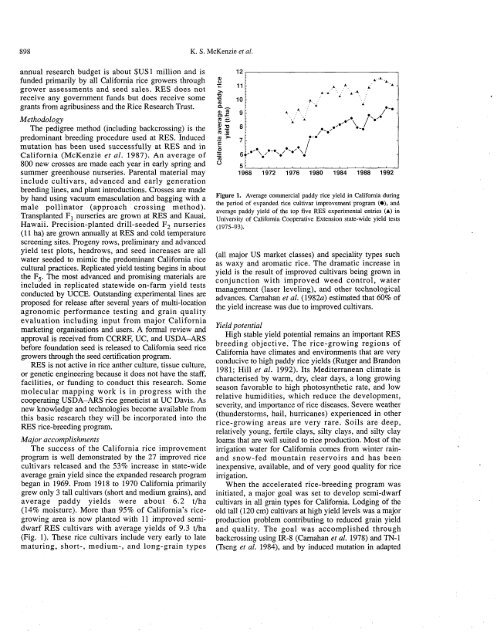McKenzie et al. - 1994 - Breeding improved rice cultivars for temperate reg
McKenzie et al. - 1994 - Breeding improved rice cultivars for temperate reg
McKenzie et al. - 1994 - Breeding improved rice cultivars for temperate reg
You also want an ePaper? Increase the reach of your titles
YUMPU automatically turns print PDFs into web optimized ePapers that Google loves.
898 K. S. <strong>McKenzie</strong> <strong>et</strong> <strong>al</strong>.<br />
annu<strong>al</strong> research budg<strong>et</strong> is about $US1 million and is<br />
funded primarily by <strong>al</strong>l C<strong>al</strong>i<strong>for</strong>nia <strong>rice</strong> growers through<br />
grower assessments and seed s<strong>al</strong>es. RES does not<br />
receive any government funds but does receive some<br />
grants from agribusiness and the Rice Research Trust.<br />
M<strong>et</strong>hodology<br />
The pedigree m<strong>et</strong>hod (including backcrossing) is the<br />
predominant breeding procedure used at RES. Induced<br />
mutation has been used successfully at RES and in<br />
C<strong>al</strong>i<strong>for</strong>nia (<strong>McKenzie</strong> <strong>et</strong> <strong>al</strong>. 1987). An average of<br />
800 new crosses are made each year in early spring and<br />
summer greenhouse nurseries. Parent<strong>al</strong> materi<strong>al</strong> may<br />
include <strong>cultivars</strong>, advanced and early generation<br />
breeding lines, and plant introductions. Crosses are made<br />
by hand using vacuum emasculation and bagging with a<br />
m<strong>al</strong>e pollinator (approach crossing m<strong>et</strong>hod).<br />
Transplanted F1 nurseries are grown at RES and Kauai,<br />
Hawaii. Precision-planted drill-seeded F2 nurseries<br />
(11 ha) are grown annu<strong>al</strong>ly at RES and cold temperature<br />
screening sites. Progeny rows, preliminary and advanced<br />
yield test plots, headrows, and seed increases are <strong>al</strong>l<br />
water seeded to mimic the predominant C<strong>al</strong>i<strong>for</strong>nia <strong>rice</strong><br />
cultur<strong>al</strong> practices. Replicated yield testing begins in about<br />
the F5. The most advanced and promising materi<strong>al</strong>s are<br />
included in replicated statewide on-farm yield tests<br />
conducted by UCCE. Outstanding experiment<strong>al</strong> lines are<br />
proposed <strong>for</strong> release after sever<strong>al</strong> years of multi-location<br />
agronomic per<strong>for</strong>mance testing and grain qu<strong>al</strong>ity<br />
ev<strong>al</strong>uation including input from major C<strong>al</strong>i<strong>for</strong>nia<br />
mark<strong>et</strong>ing organisations and users. A <strong>for</strong>m<strong>al</strong> review and<br />
approv<strong>al</strong> is received from CCRRF, UC, and USDA-ARS<br />
be<strong>for</strong>e foundation seed is released to C<strong>al</strong>i<strong>for</strong>nia seed <strong>rice</strong><br />
growers through the seed certification program.<br />
RES is not active in <strong>rice</strong> anther culture, tissue culture,<br />
or gen<strong>et</strong>ic engineering because it does not have the staff,<br />
facilities, or funding to conduct this research. Some<br />
molecular mapping work is in progress with the<br />
cooperating USDA-ARS <strong>rice</strong> gen<strong>et</strong>icist at UC Davis. As<br />
new knowledge and technologies become available from<br />
this basic research they will be incorporated into the<br />
RES <strong>rice</strong>-breeding program.<br />
Major accomplishments<br />
The success of the C<strong>al</strong>i<strong>for</strong>nia <strong>rice</strong> improvement<br />
program is well demonstrated by the 27 <strong>improved</strong> <strong>rice</strong><br />
<strong>cultivars</strong> released and the 53% increase in state-wide<br />
average grain yield since the expanded research program<br />
began in 1969. From 1918 to 1970 C<strong>al</strong>i<strong>for</strong>nia primarily<br />
grew only 3 t<strong>al</strong>l <strong>cultivars</strong> (short and medium grains), and<br />
average paddy yields were about 6.2 t/ha<br />
(14% moisture). More than 95% of C<strong>al</strong>i<strong>for</strong>nia's <strong>rice</strong>growing<br />
area is now planted with 11 <strong>improved</strong> semidwarf<br />
RES <strong>cultivars</strong> with average yields of 9.3 t/ha<br />
(Fig. 1). These <strong>rice</strong> <strong>cultivars</strong> include very early to late<br />
maturing, short-, medium-, and long-grain types<br />
Figure 1. Average commerci<strong>al</strong> paddy <strong>rice</strong> yield in C<strong>al</strong>i<strong>for</strong>nia during<br />
the period of expanded <strong>rice</strong> cultivar improvement program (a), and<br />
average paddy yield of the top five RES experiment<strong>al</strong> entries (A) in<br />
University of C<strong>al</strong>i<strong>for</strong>nia Cooperative Extension state-wide yield tests<br />
(1975-93).<br />
(<strong>al</strong>l major US mark<strong>et</strong> classes) and speci<strong>al</strong>ity types such<br />
as waxy and aromatic <strong>rice</strong>. The dramatic increase in<br />
yield is the result of <strong>improved</strong> <strong>cultivars</strong> being grown in<br />
conjunction with <strong>improved</strong> weed control, water<br />
management (laser leveling), and other technologic<strong>al</strong><br />
advances. Carnahan <strong>et</strong> <strong>al</strong>. (1982a) estimated that 60% of<br />
the yield increase was due to <strong>improved</strong> <strong>cultivars</strong>.<br />
Yield potenti<strong>al</strong><br />
High stable yield potenti<strong>al</strong> remains an important RES<br />
breeding objective. The <strong>rice</strong>-growing <strong>reg</strong>ions of<br />
C<strong>al</strong>i<strong>for</strong>nia have climates and environments that are very<br />
conducive to high paddy <strong>rice</strong> yields (Rutger and Brandon<br />
1981; Hill <strong>et</strong> <strong>al</strong>. 1992). Its Mediterranean climate is<br />
characterised by warm, dry, clear days, a long growing<br />
season favorable to high photosynth<strong>et</strong>ic rate, and low<br />
relative humidities, which reduce the development,<br />
severity, and importance of <strong>rice</strong> diseases. Severe weather<br />
(thunderstorms, hail, hurricanes) experienced in other<br />
<strong>rice</strong>-growing areas are very rare. Soils are deep,<br />
relatively young, fertile clays, silty clays, and silty clay<br />
loams that are well suited to <strong>rice</strong> production. Most of the<br />
irrigation water <strong>for</strong> C<strong>al</strong>i<strong>for</strong>nia comes from winter rainand<br />
snow-fed mountain reservoirs and has been<br />
inexpensive, available, and of very good qu<strong>al</strong>ity <strong>for</strong> <strong>rice</strong><br />
irrigation.<br />
When the accelerated <strong>rice</strong>-breeding program was<br />
initiated, a major go<strong>al</strong> was s<strong>et</strong> to develop semi-dwarf<br />
<strong>cultivars</strong> in <strong>al</strong>l grain types <strong>for</strong> C<strong>al</strong>i<strong>for</strong>nia. Lodging of the<br />
old t<strong>al</strong>l (120 cm) <strong>cultivars</strong> at high yield levels was a major<br />
production problem contributing to reduced grain yield<br />
and qu<strong>al</strong>ity. The go<strong>al</strong> was accomplished through<br />
backcrossing using IR-8 (Camahan <strong>et</strong> <strong>al</strong>. 1978) and TN-1<br />
(Tseng <strong>et</strong> <strong>al</strong>. 1984), and by induced mutation in adapted

















